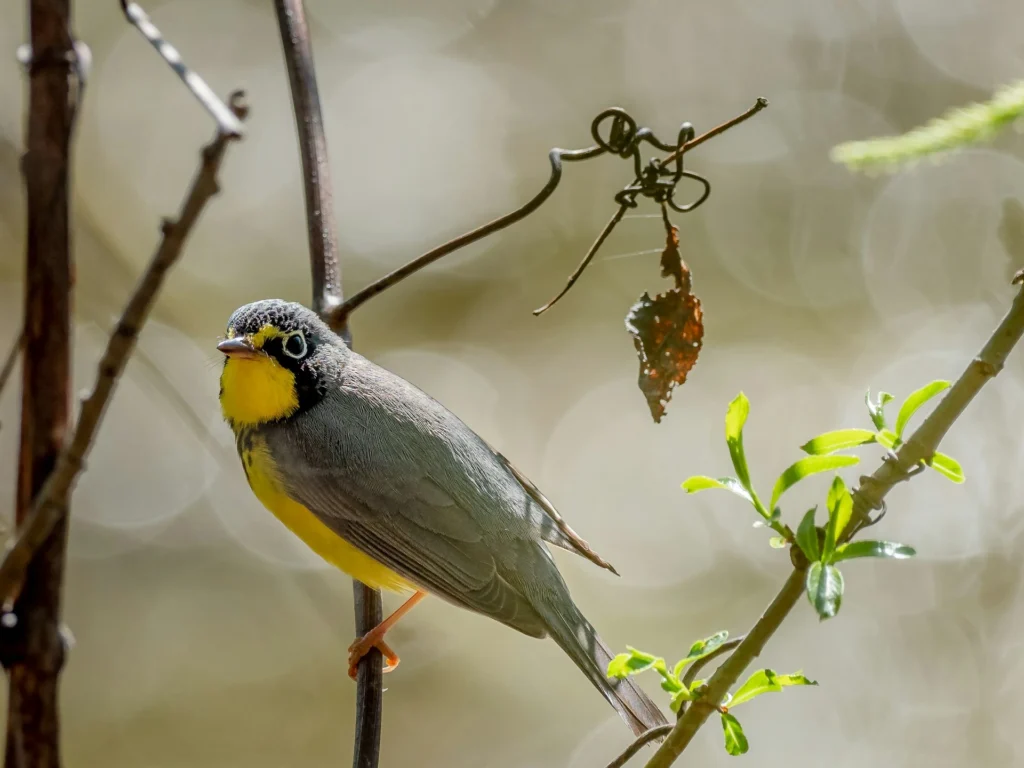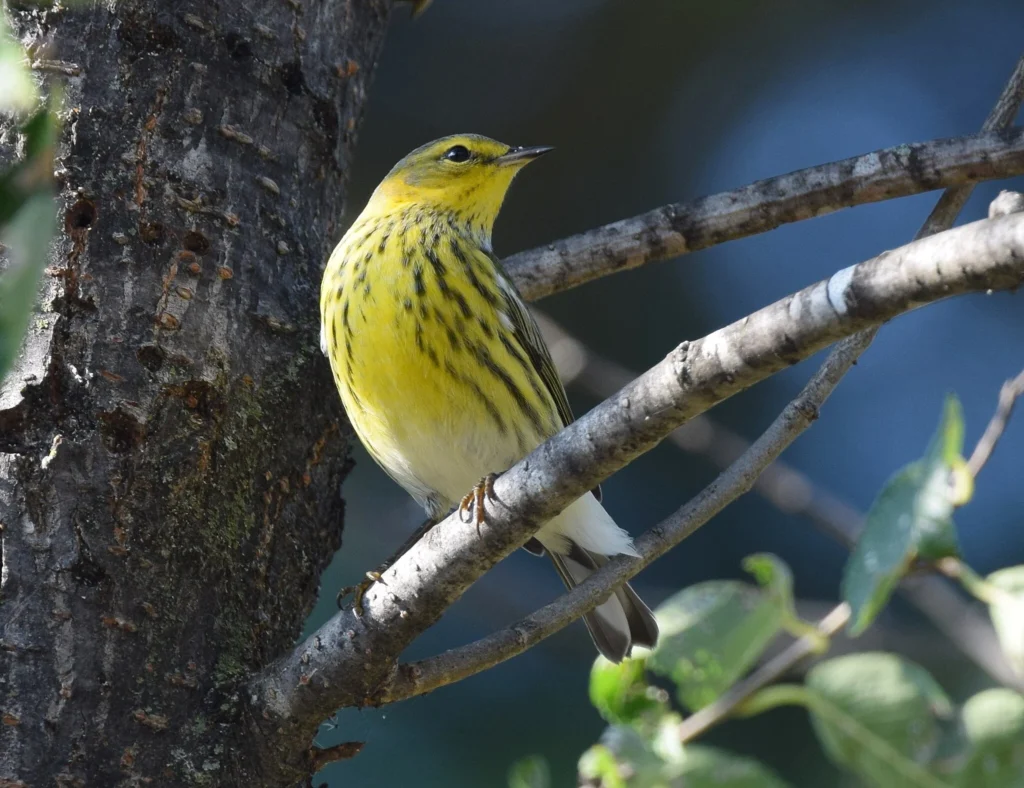Michigan is a haven for bird enthusiasts, particularly those keen on vibrant colors. The state is home to a diverse array of yellow-feathered birds, each adding a splash of sunshine to the natural landscape.
Their bright plumage not only makes them easy to spot but also incredibly attractive to bird watchers and nature lovers alike. In this article, we will delve into the fascinating world of Michigan’s yellow birds, uncovering the secrets behind their allure and providing detailed insights into their unique characteristics and behaviors.
Whether you’re a seasoned birder or a curious newcomer, prepare to be enchanted by the diverse and colorful avian residents of Michigan. This guide explores these and other yellow-breasted birds that grace Michigan, inviting you to discover their beauty and diversity.
Here’s a list of 14 yellow birds in Michigan –
Table of Contents
Types of Yellow Birds in Michigan
1. American Goldfinch

The American Goldfinch, a striking yellow bird, is a familiar sight in Michigan, captivating bird watchers with its vibrant plumage and cheerful song. Male goldfinches display a brilliant yellow color with contrasting black wings and a cap, while females are more subdued in their olive-brown tones.
These birds thrive in open fields, meadows, and suburban gardens, often seen flitting among thistles and sunflowers, their preferred food sources. Goldfinches are unique for their late breeding season, which aligns with the peak abundance of seeds in mid-summer. The American Goldfinch is not just a symbol of summer but also a reminder of the state’s rich natural beauty.
Also read: Types of Red birds in South Carolina
2. Canada Warbler

The Canada Warbler is a small, lively bird known for its bright yellow underparts and distinctive “necklace” of black streaks across its chest. This warbler thrives in dense, wet forests and shady ravines, often skulking in the underbrush.
Its diet mainly consists of insects like flies, beetles, and caterpillars, which it actively forages among the leaves. The Canada Warbler’s striking appearance and energetic behavior, coupled with its melodious song, make it a delightful presence in its preferred habitats during the breeding season.
Diet:
Primarily eats insects, particularly favoring flies, beetles, and caterpillars.
Habitat:
Prefers dense, wet forests and shady ravines, often skulking in the underbrush.

3. American Yellow Warbler

cc: https://ebird.org/species/yelwar?siteLanguage=en_PH
The American Yellow Warbler is a vibrant songbird known for its bright yellow plumage, making it a standout among Michigan’s avian residents. These small birds are widespread across North America, breeding in young forests and shrublands from the Arctic Circle to Mexico.
Their diet primarily consists of insects, especially caterpillars, which forage from the tops of shrubs and small trees. During winter, they migrate to Central and South America, where they also consume fruit.
The American Yellow Warbler’s cheerful song and energetic foraging behavior make it a delightful presence in both temperate and tropical habitats.
Diet:
These birds are insect hunters, darting among shrubs and trees to catch caterpillars and other insect larvae. During winter, they also snack on fruit.
Habitat:
Yellow Warblers migrate north each spring to nest in young forests and shrublands from the Arctic Circle to Mexico. Come autumn, they head south to Central and South America, often wintering in mangrove forests.
4. Common Yellowthroat

The Common Yellowthroat is a small warbler with a vibrant yellow throat and breast, accented by a bold black mask on the males. This lively bird is often found in wetlands, marshes, and overgrown fields, where it forages for insects and spiders.
Known for its distinctive “Wichita-Wichita” song, the Common Yellowthroat is a vocal and energetic presence in its habitat. Its bright plumage and active behavior make it a favorite among birdwatchers, adding a cheerful note to the wetland symphony.
Diet:
Feasts on insects and spiders, foraging low in dense vegetation.
Habitat:
Prefers wetlands, marshes, and overgrown fields where its “wichity-wichity” song can be heard.
5. American Redstart

The American Redstart is a flashy bird. Males sport striking black feathers with bright reddish-orange patches on their sides, wings, and tail, while females are more subdued with yellow markings. These lively birds are a joy to watch as they flit through the trees, fanning their tails and flashing their colors to startle insects into flight.
Diet:
These birds have a varied diet, mainly munching on insects like beetles, caterpillars, moths, and leafhoppers. They also enjoy spiders, daddy longlegs, and occasionally seeds and berries.
Habitat:
American Redstarts breed in open wooded areas, especially those with plenty of deciduous trees. During migration, they can be found in nearly any treed habitat, and they spend their winters in tropical woodlands and open forests.
6. Baltimore Oriole

The Baltimore Oriole is a striking blackbird with vibrant orange and black plumage. These birds are named after Lord Baltimore’s coat of arms and are a delightful sight in eastern North America. They migrate south from late summer to early fall, spending their winters in the Southeast U.S., Central America, or South America until April.
Diet:
Insects, berries, and nectar make up the bulk of the Baltimore Oriole’s diet. They feast on caterpillars, beetles, grasshoppers, wasps, bugs, spiders, and snails. They also enjoy berries and sometimes cultivated fruit.
Habitat:
Baltimore Orioles thrive in open deciduous woodlands and are also common in community parks and suburban backyards.
7. Baltimore Oriole (Female)

The female Baltimore Oriole is a lovely bird with a subtle blend of yellow and orange hues, less vibrant than the male but equally captivating. She’s often found in open woodlands, parks, and gardens, where she skillfully weaves a hanging nest from plant fibers.
Her diet consists of insects, fruit, and nectar, making her a frequent visitor to backyard feeders. Despite her quieter coloration, she plays a crucial role in the ecosystem by controlling insect populations and aiding in plant pollination. Spotting a female Baltimore Oriole adds a touch of sunshine to any birdwatching excursion.
Diet:
She loves insects, fruits, and nectar, often seen sipping from flowers or feeders.
Habitat:
Prefers open woodlands, parks, and suburban gardens where she builds her distinctive hanging nest.
8. Bell’s Vireo

Wildreturn, CC BY 2.0, via Wikimedia Commons
Bell’s Vireo is a small, energetic bird with a touch of yellow on its sides and a penchant for staying well hidden in dense shrubbery. Known for its persistent and cheerful song, this vireo primarily feeds on insects and spiders, which it skillfully hunts among the leaves and branches.
Preferring shrubby areas, thickets, and riparian zones, Bell’s Vireo is often more easily heard than seen. Despite its modest size and coloring, it’s a dynamic presence in its habitat, contributing to insect control and bringing a lively soundtrack to the places it inhabits.
Diet:
Primarily insectivorous, snacking on a variety of insects and spiders.
Habitat:
Enjoys shrubby areas, thickets, and riparian zones where it can stay well-hidden while singing its heart out.
9. Black-throated Green Warbler

The Black-throated Green Warbler is a striking bird with its vivid yellow-green back, black throat, and contrasting white belly. This small songbird is a common sight in Michigan’s mixed forests, especially where coniferous and deciduous trees intermingle.
Its diet primarily consists of insects, with caterpillars being a particular favorite, and it occasionally snacks on berries. Known for its distinctive and melodic song, the Black-throated Green Warbler adds both visual and auditory delight to its environment, making it a favorite among birdwatchers during the breeding season.
Diet:
Feeds on insects, especially caterpillars, and occasionally berries.
Habitat:
Found in mixed forests, particularly in coniferous and deciduous woodlands during the breeding season.
10. Blue-Winged Warbler

The Blue-winged Warbler is a vibrant, lemon-yellow bird with soft blue-gray wings and a black eye stripe. It’s a dynamic forager, darting through shrubs and low trees in search of insects and spiders.
Preferring brushy fields, forest edges, and young forests, this warbler is often heard before it’s seen, thanks to its distinctive buzzing song. The Blue-winged Warbler’s bright coloration and lively behavior make it a delightful sight, adding a splash of color and energy to the landscapes it inhabits during the breeding season.
Diet:
Insects and spiders make up the bulk of its diet, often foraging in shrubs and low trees.
Habitat:
Prefers brushy fields, forest edges, and young forests, where its buzzing song can be heard.
Check more on World Birds Life.
11. Bullock’s Oriole

Gregory “Slobirdr” Smith, CC BY-SA 2.0, via Wikimedia Commons
The Bullock’s Oriole is a western cousin to the Baltimore Oriole, showcasing stunning yellow and black plumage with a touch of white. This medium-sized songbird is often found in open woodlands and areas with abundant trees, where it builds intricate hanging nests.
Its diet includes insects, fruit, and nectar, making it a versatile feeder and a welcome visitor to gardens and parks. The Bullock’s Oriole’s striking appearance and melodic song make it a favorite among birdwatchers, adding a vibrant splash of color to the regions it inhabits.
Diet:
Enjoys insects, fruit, and nectar, often seen foraging high in the trees.
Habitat:
Found in open woodlands, especially those with plenty of trees for nesting.
12. Cedar Waxwing

The Cedar Waxwing is an elegant bird with sleek yellow underparts, a distinctive crest, and waxy red tips on its wing feathers. These birds are often seen in flocks, adding a touch of sophistication to the landscape.
Their diet is heavily fruit-based, but they also catch insects on the wing. Cedar Waxwings prefer open woodlands, orchards, and gardens, especially where fruit-bearing trees and shrubs are plentiful. Their social nature and striking appearance make them a charming and entertaining sight for bird enthusiasts year-round.
Diet:
Berries are their favorite, but they also catch insects on the wing.
Habitat:
Found in open woodlands, orchards, and gardens, especially where fruit-bearing trees and shrubs are plentiful.
13. Couch’s Kingbird

HarmonyonPlanetEarth, CC BY 2.0, via Wikimedia Commons
Couch’s Kingbird is a robust and striking bird with a bright yellow belly and a commanding presence. Known for its aggressive behavior in defending its territory, this kingbird primarily feeds on insects but also enjoys fruit and berries.
It prefers open areas with scattered trees, often perching conspicuously as it surveys for prey. Couch’s Kingbird’s bold coloring and assertive nature make it a fascinating bird to observe, adding a splash of color and drama to the landscapes it inhabits.
Diet:
Primarily feeds on insects, but also enjoys fruit and berries.
Habitat:
Found in open areas with scattered trees, often perched conspicuously as it surveys for prey.
14. Cape May Warbler

Andy Reago & Chrissy McClarren, CC BY 2.0, via Wikimedia Commons
The Cape May Warbler is a striking bird with a yellow face, chestnut cheek patch, and bold streaks on its chest. This small songbird primarily feeds on insects during the breeding season and turns to nectar and fruit in the winter.
Preferring northern coniferous forests for breeding, it migrates through Michigan, where it can be spotted in various wooded areas. The Cape May Warbler’s vibrant coloring and distinctive markings make it a favorite among birdwatchers, adding a splash of color and excitement during migration seasons.
Diet:
Feeds on insects, especially during the breeding season, and enjoys nectar and fruit in the winter.
Habitat:
Breeds in northern coniferous forests and migrates through Michigan, where it can be spotted in various wooded areas.
So, these were the most popular yellow birds you could spot in Michigan. Hope you enjoy it!

Welcome to World Birds Life, where the wonder of birds takes center stage. My name is Lexi, and I’m passionate about helping you discover the beauty and joy that birds bring into our lives.







